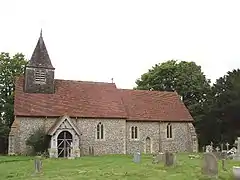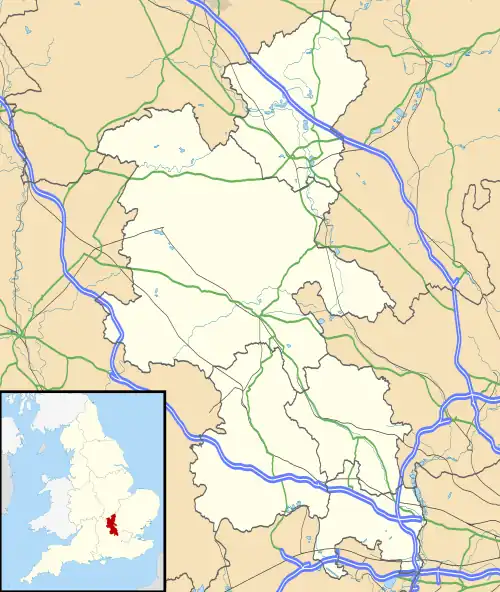Saunderton
Saunderton is a village and former civil parish, now in the parish of Bledlow-cum-Saunderton, Buckinghamshire, England. It is in the Saunderton Valley in the Chiltern Hills, the village consists of three main areas: a linear settlement along Bledlow Road about 1+1⁄4 miles (2 km) southwest of Princes Risborough, Saunderton Lee, about 1+1⁄2 miles (2 km) further south and a residential area on the A4010 road around Saunderton railway station (on the Chiltern Main Line), about 4+1⁄2 miles (7 km) northwest of High Wycombe. This residential area, unlike the other two parts of the village, is in the HP14 postcode district, meaning its post town is High Wycombe, not Princes Risborough, the boundary between the two post towns passing just south of Grange Farm. In 1931 the parish had a population of 454.[1]
| Saunderton | |
|---|---|
 SS Mary and Nicholas parish church | |
 Saunderton Location within Buckinghamshire | |
| OS grid reference | SU8198 |
| • London | 33 mi (53 km) |
| Civil parish | |
| Unitary authority | |
| Ceremonial county | |
| Region | |
| Country | England |
| Sovereign state | United Kingdom |
| Post town | Princes Risborough, High Wycombe |
| Postcode district | HP27, HP14 |
| Dialling code | 01844, 01494 |
| Police | Thames Valley |
| Fire | Buckinghamshire |
| Ambulance | South Central |
| UK Parliament | |
| Website | Bledlow-cum-Saunderton Parish Council |
History
The toponym "Saunderton" is derived from Old English, but its original meaning is not clear. The Domesday Book of 1086 records it as Santesdune, leading some scholars to believe that the village name derives from "saint's hill".
In the 18th century a workhouse was founded in Saunderton, which in the Victorian era became the main workhouse for the Union of High Wycombe. It became one of the most secure houses in the region and regular absconders from other workhouses were often moved here because of its remote location. Inmates were taken to the workhouse by a constable, but if they wanted to leave they had a long walk ahead of them.
Saunderton Estate is in the village. The building was constructed in 1959 and redeveloped in 1994 with the addition of two wings of two-storey offices.
On 1 April 1934 the parish was abolished to form "Bledlow cum Saunderton".[2]
Parish church
The Church of England parish church of SS Mary and Nicholas was built in 1227 and originally dedicated solely to St Mary. But Saunderton had a second parish church, St Nicholas, that fell into decay. In 1452 St Nicholas' church was demolished, and St Mary's was given the double dedication to St Nicholas as well.[3]
In 1886 the church's walls began to lean inwards, so the church was largely dismantled in 1888 and rebuilt over the next three years.[3] Its 12th- or 13th-century font was reused and the 14th-century windows were restored and re-used. It is a Grade II* listed building.[4]
The church has a small, timber-framed bell tower. It has three bells, all of which the bellfounder Alexander Rigby of Stamford, Lincolnshire cast in 1699. For technical reasons they are currently unringable.[5]
SS Mary and Nicholas church is part of the parish of Bledlow with Saunderton and Horsenden,[6] which in turn is part of the Benefice of Risborough.[7]
References
- "Population statistics Saunderton AP/CP through time". A Vision of Britain through Time. Retrieved 9 August 2023.
- "Relationships and changes Saunderton AP/CP through time". A Vision of Britain through Time. Retrieved 9 August 2023.
- Hall, Cynthia. "Saunderton, St Mary & St Nicholas". The Parish of Bledlow with Saunderton and Horsenden. Retrieved 11 April 2015.
- Historic England. "Church of St Mary (sic) (Grade II*) (1332059)". National Heritage List for England. Retrieved 11 April 2015.
- Davies, Peter (23 December 2006). "Saunderton SS Mary & Nicholas". Dove's Guide for Church Bell Ringers. Central Council for Church Bell Ringers. Retrieved 11 April 2015.
- Archbishops' Council. "Bledlow with Saunderton and Horsenden". A Church Near You. Church of England. Retrieved 11 April 2015.
- Archbishops' Council. "Benefice of Risborough". A Church Near You. Church of England. Retrieved 11 April 2015.
Further reading
- Page, W.H., ed. (1925). A History of the County of Bedford. Victoria County History. Vol. 3. Westminster: Archibald Constable & Co. pp. 92–95.
- Pevsner, Nikolaus (1960). Buckinghamshire. The Buildings of England. Harmondsworth: Penguin Books. pp. 231–232. ISBN 0-14-071019-1.
- RCHME, ed. (1912). An Inventory of the Historical Monuments in Buckinghamshire. Vol. 1, South. London: Her Majesty's Stationery Office. pp. 276–277.
